EXPERIENCING STATISTICS AT A DISTANCE
advertisement
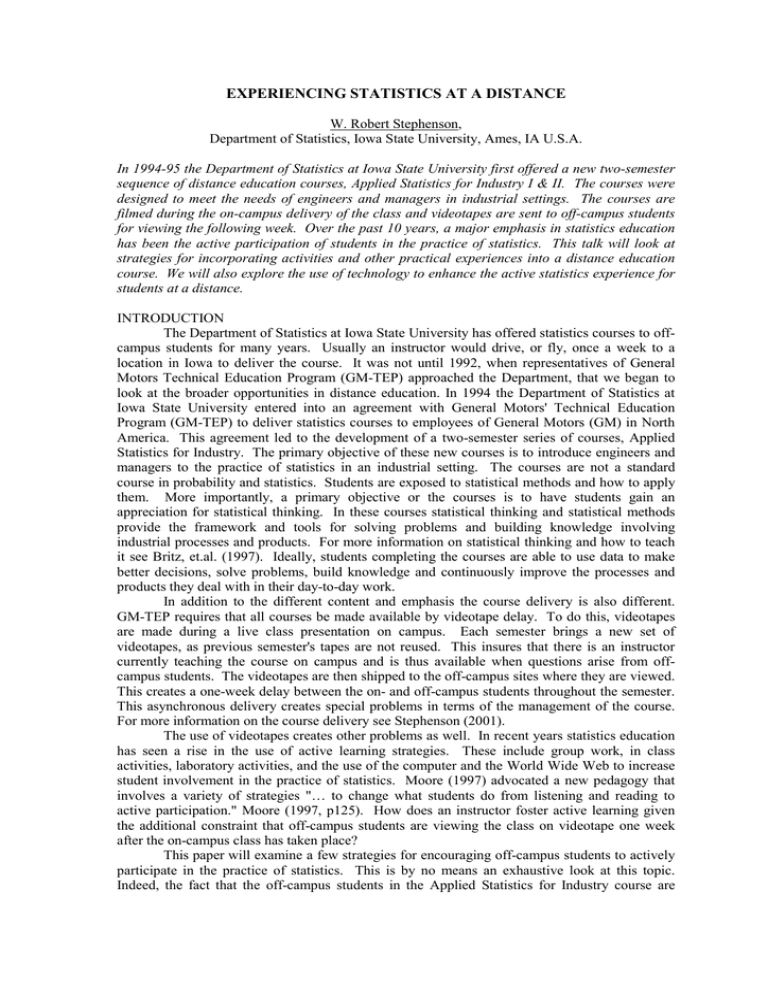
EXPERIENCING STATISTICS AT A DISTANCE W. Robert Stephenson, Department of Statistics, Iowa State University, Ames, IA U.S.A. In 1994-95 the Department of Statistics at Iowa State University first offered a new two-semester sequence of distance education courses, Applied Statistics for Industry I & II. The courses were designed to meet the needs of engineers and managers in industrial settings. The courses are filmed during the on-campus delivery of the class and videotapes are sent to off-campus students for viewing the following week. Over the past 10 years, a major emphasis in statistics education has been the active participation of students in the practice of statistics. This talk will look at strategies for incorporating activities and other practical experiences into a distance education course. We will also explore the use of technology to enhance the active statistics experience for students at a distance. INTRODUCTION The Department of Statistics at Iowa State University has offered statistics courses to offcampus students for many years. Usually an instructor would drive, or fly, once a week to a location in Iowa to deliver the course. It was not until 1992, when representatives of General Motors Technical Education Program (GM-TEP) approached the Department, that we began to look at the broader opportunities in distance education. In 1994 the Department of Statistics at Iowa State University entered into an agreement with General Motors' Technical Education Program (GM-TEP) to deliver statistics courses to employees of General Motors (GM) in North America. This agreement led to the development of a two-semester series of courses, Applied Statistics for Industry. The primary objective of these new courses is to introduce engineers and managers to the practice of statistics in an industrial setting. The courses are not a standard course in probability and statistics. Students are exposed to statistical methods and how to apply them. More importantly, a primary objective or the courses is to have students gain an appreciation for statistical thinking. In these courses statistical thinking and statistical methods provide the framework and tools for solving problems and building knowledge involving industrial processes and products. For more information on statistical thinking and how to teach it see Britz, et.al. (1997). Ideally, students completing the courses are able to use data to make better decisions, solve problems, build knowledge and continuously improve the processes and products they deal with in their day-to-day work. In addition to the different content and emphasis the course delivery is also different. GM-TEP requires that all courses be made available by videotape delay. To do this, videotapes are made during a live class presentation on campus. Each semester brings a new set of videotapes, as previous semester's tapes are not reused. This insures that there is an instructor currently teaching the course on campus and is thus available when questions arise from offcampus students. The videotapes are then shipped to the off-campus sites where they are viewed. This creates a one-week delay between the on- and off-campus students throughout the semester. This asynchronous delivery creates special problems in terms of the management of the course. For more information on the course delivery see Stephenson (2001). The use of videotapes creates other problems as well. In recent years statistics education has seen a rise in the use of active learning strategies. These include group work, in class activities, laboratory activities, and the use of the computer and the World Wide Web to increase student involvement in the practice of statistics. Moore (1997) advocated a new pedagogy that involves a variety of strategies "… to change what students do from listening and reading to active participation." Moore (1997, p125). How does an instructor foster active learning given the additional constraint that off-campus students are viewing the class on videotape one week after the on-campus class has taken place? This paper will examine a few strategies for encouraging off-campus students to actively participate in the practice of statistics. This is by no means an exhaustive look at this topic. Indeed, the fact that the off-campus students in the Applied Statistics for Industry course are working in industry makes them a special audience. An audience that is often more motivated to see the practical application of statistical methods and thinking. COURSE CONTENT AND PEDAGOGY The course, Applied Statistics for Industry, was designed with the recommendations of the ASA/MAA Joint Curriculum Committee in mind. The brief form of the committee's recommendations, as approved by the Board of Directors of the American Statistical Association (ASA) appears in Moore (1997, pg. 127) and is repeated below. 1. Emphasize the elements of statistical thinking: · the need for data, · the importance of data production, · the omnipresence of variability, · the measuring and modeling of variability 2. Incorporate more data and concepts, fewer recipes and derivations. Wherever possible, automate computations and graphics. An introductory course should: · rely heavily on real (not merely realistic) data, · emphasize statistical concepts, e.g., causation vs. association, experimental vs. observational and longitudinal vs. cross-sectional studies, · rely on computers rather than computational recipes, · treat formal derivations as secondary in importance. 3. Foster active learning, through the following alternatives to lecturing: · Group problem solving and discussion, · Laboratory exercises, · Demonstrations based on class-generated data, · Written and oral presentations, · Projects, either group or individual. This is a course about statistical thinking and so the elements in recommendation 1 formed the basis for the structure of the course. One of the fundamental ideas in this course is that without data you are just another person with an opinion. It is only through data that one can move from opinion to knowledge. An iterative cycle of data production and analysis is used to build knowledge about processes and products. Inherent in data is variability. Recognizing, quantifying and trying to identify sources of variability are major themes of the course. Because this is a course taken by very busy working managers and engineers, data and concepts are foremost. These students want to be able to use the methods and ideas of the course in their work. Real data from the automotive and other industries is central to the content of the courses. Computation and graphics are fundamental tools and all students have access to suitable statistical software (e.g. Minitab, JMP). The third recommendation is more difficult to incorporate given the videotape delay format for off-campus students. Group problem solving and discussion in class is limited to the on-campus students unless there are several students at each off-campus site. In the following two sections I will focus on some examples of in class exercises that generate data and projects that include written presentations. IN CLASS DEMONSTRATIONS Since the class is taught on campus to a "live" audience there is the opportunity to do in class demonstrations and activities. These must be designed in such a way that the message from the in class demonstration transfers to videotape. In each of the courses, Applied Statistics for Industry I & II, I try to include class demonstration activities that are done by the students on campus. Off-campus students are encouraged to participate in the activity when they view the videotape. The data generated by the in class students form the basis for discussion. Since there is the one-week delay for the off-campus students, their data cannot be included in the immediate discussion. However, their experiences are shared with the class at a later time. The theme of Applied Statistics for Industry I is the careful observation of processes. Therefore observational studies form the foundation of data collection. Since your analysis is only as good as the data that goes into it, a good deal of time is spent on discussing ideas of measurement and potential sources of variability. One of the in class demonstration/activities we do involves the seemingly simple task of measuring a distance between a camshaft and a crankshaft. The students are presented with a schematic of the camshaft, crankshaft and timing chain for a car engine. The schematic appears below. Camshaft Crankshaft The students are given a ruler and asked to measure the distance from the camshaft to the crankshaft. In order to introduce a source of variability, students with ID numbers ending in 0, 2, 4, 6 or 8 measure in centimeters. All other students measure in inches and convert to centimeters by multiplying by 2.54 cm/in. Off-campus students are encouraged to make the measurement as well. They are provided with a copy of the schematic and a small plastic ruler in their course packet. The students are given a few minutes to make their measurements. The video camera scans the classroom. Off-campus students see that this is a part of the class and they should be making a measurement as well. The on-campus students then share their values and a discussion of sources of variability begins. It is quite surprising how difficult a task this turns out to be. Students are unsure of what distance they should measure. Some measure from the center of the camshaft to the center of the crankshaft. Others measure from the bottom of the camshaft to the top of the crankshaft. This difference in the definition of the distance is easy to spot from the data. The variation due to the measurement method, metric versus a conversion from inches to centimeters, is subtler. After some discussion students notice that about half of the measurements are recorded to one decimal place while others often have 4 or 5. The 4 or 5 decimal places are not due to a more precise measuring device but to the multiplication of inches by 2.54 cm/in. Students using the same definition and measuring method still do not get the same value all of the time. The idea of "operator" variation is seen first hand. This is the first introduction to the idea that data can contain clues about potential sources of variation. The theme of Applied Statistics for Industry II is designed experiments. We use a paper helicopter to motivate the design, collection and analysis of experimental data. The paper helicopter as an aid to teaching design of experiments has been around for quite some time. I first heard of it from George Box, Soren Bisgaard and Conrad Fung at the University of Wisconsin. Box (1992) discusses the use of a paper helicopter to teach engineers experimental design. The paper helicopter we use in the Applied Statistics for Industry II course is depicted below. In order for it to fly, the wings are created by cutting down the centerline and folding, one wing forward 4.5 cm 4.5 cm 8 cm 5 cm 10 cm 3 cm and one wing back. A paper clip must be attached at the bottom to insure a stable flight. An in class exercise that is done fairly early in the semester is to have students come up with a hypothesis about how changing one thing about the helicopter will affect flight time. For example, a 10 cm wing length will have a longer flight time than an 8 cm wing length. Or, attaching three paper clips will shorten the flight time compared to attaching one paper clip. The students then spend the class constructing, flying and timing helicopters. The students must then analyze their data and reach a conclusion about their hypothesis. The on-campus students are filmed working on this exercise. The off-campus students soon realize that they will not get much out of watching the videotape of others collecting data. They must also come up with a hypothesis and data of their own. PROJECTS Probably the most effective means of actively engaging distance education students in the practice of statistics is through projects. Each semester I require students in Applied Statistics for Industry to complete a project. During the course of the semester they have seen class demonstrations and homework assignments covering specific topics. The project allows the opportunity to put together everything they have learned. The use of projects in statistics courses is not new. Jowett and Davies (1960) and Scott (1975) are, to my knowledge, the earliest references to the use of projects in the teaching of statistics. Bisgaard (1991) recommends the use of projects in statistics courses for engineers. In Applied Statistics for Industry I, the focus is on observing and monitoring processes. During the course of the semester we look at processes and tools that can be used to build knowledge about them. The project provides the opportunity to put this information into practice. Students, individually or in groups, must choose a process and using the tools discussed in class tell me what they have learned about it. The process chosen can be one from work or one from everyday life. Students are given guidance on what they should include in the project and how the final report should be written. For more details see the project guidelines on the course website, http://www.public.iastate.edu/~wrstephe/stat495.html. Over the six years this course has been taught there have been some really interesting topics chosen. The off-campus students tend to choose topics related to work. These tend to be more interesting than the topics chosen by on-campus students. The more interesting projects also serve as a source of real data for the future. Some of the topics chosen include; leak rates for cylinder heads, distortion in a cast product, part cleanliness, a valve balance measurement system, ice cream production, a wafer forming process, manufacturing plant safety, Global Positioning System receiver performance and light output of a fluorescent lamp in a liquid crystal display. There are two sample projects on the website. These are used to help guide students as they plan, execute and eventually write up the results of their project. The project is very effective in getting students to actually practice statistics. Many students comment on course evaluations that the project was an excellent way to connect the various methods and ideas from the course. Many of the off-campus students used the course project in their work. After the course is over, I hear from many of the off-campus students telling me how they are continuing to use the ideas and techniques presented in the course. In the second course, Applied Statistics for Industry II, there is also a project. Since the focus of this course in on statistical design of experiments, the project deals with designing a fairly complex fractional factorial experiment. Everyone designs an experiment using the paper helicopter. I initially thought that it would be better to have each student, or group of students, pick a topic and design an experiment to answer a question about that topic. This turned out to be unmanageable. Off-campus students tended to design very involved experiments and then did not have the time to actually run the experiment, collect and analyze the data within the time frame of an academic semester. On-campus students tended to design simple experiments that did not cover the scope of the material presented in the course. With the paper helicopter, I am able to set up a scenario that is realistic enough to motivate the need for an efficient design and careful execution of a fairly complex experiment. The main experiment looks at the effects of at least seven factors on the flight time of the paper helicopter. The factors change from year to year. Students have to be complete in their analysis but efficient in terms of the number of runs they make. A lower score is given for someone who uses too many resources (i.e. has too many runs). Most students choose a fractional factorial design. They must justify their choice in terms of efficiency and resolution. Extra credit is given for students who follow up on an initial experiment and make specific suggestions for further experimentation. An example of a written project appears on the course website; http://www.public.iastate.edu/~wrstephe/stat496.html. The students really enjoy this project. Off-campus students comment that although the paper helicopter project does not directly relate to their work, they can better appreciate how to design an experiment for their work. If they do something wrong and have to redo part of the helicopter experiment, they are thankful they have not wasted company resources. They are more aware of the things that can go wrong with an experiment and also gain an appreciation for building up slowly, moving from simple to more complex experiments. FUTURE DEVELOPMENTS At the time we began offering these courses to GM-TEP and later to other companies, the use of the internet for the delivery of the course was not an option. General Motors did not allow their employees to access the internet. Even email was not an option. General Motors had an internal email system but there were firewalls preventing access outside of General Motors. This was due to security concerns about trade secrets. In the past few years these constraints have disappeared. Off-campus students often submit their assignments and projects as attachments to email. There is a great deal of communication via email and questions that come up during office hours, either on-campus or virtual office hours, are shared with all of the students in the class via email. We will be looking into establishing a chat room for the course. Off-campus students, especially a student who is alone at a site, would then have the opportunity to discuss the material with other students. We are currently considering putting streaming digital video on the course website. This would allow some off-campus students to access the material more quickly. It will probably not replace the videotapes being sent to the sites since streaming video needs a computer with a fast connection to the internet. We currently use one statistical package for the analysis of data. In the past we have used Minitab and students were able to purchase a copy very cheaply through the university. The next time the courses are offered we will use JMP. Off-campus students will be able to download a copy to their personal computers and use it during the semesters they are enrolled in the courses. If we can be assured that all off-campus students have computing facilities comparable to oncampus students, we can make better use of interactive activities designed for the World Wide Web. CONCLUSION Teaching statistics to students at a distance creates some unique challenges. One of the biggest challenges is to actively involve students in the practice of statistics. Just because the course is videotaped does not mean you have to abandon active learning strategies. Indeed, the videotape format almost demands that you use a variety of teaching techniques to break up the monotony of a videotaped lecture. One can still use in class activities and demonstrations. It is important to recognize that off-campus students should feel compelled to do the same activities while they are viewing the videotape. One should use projects to allow students to pull together the specific ideas and methods presented in the course. Through the use of active learning activities and technology one can change the passive activity of watching a videotape of a statistics course to experiencing the practice of statistics. REFERENCES Bisgaard, S. (1991). Teaching Statistics to Engineers, The American Statistician, 45(4), 274-283. Box, G.E.P. (1992). Teaching Engineers Experimental Design with a Paper Helicopter, Quality Engineering, 4(1), 453-359. Britz, G., Emerling, D., Hare, L., Hoerl, R. and Shade, J. (1997). How to teach others to apply statistical thinking. Quality Progress, June 1997 issue, 67-79. Jowett, G.H. and Davies, H.M. (1960). Practical Experimentation as a Teaching Method in Statistics. Journal of the Royal Statistical Society, Series A, 123, 10-36. Moore, D. (1997). New Pedagogy and New Content: The Case of Statistics. International Statistical Review, 65(2), 123-165. Scott, J.F. (1975). Practical Projects in the Teaching of Statistics at Universitites. The Statistician, 25(2), 95-108. Stephenson, W. Robert (2001). Statistics at a distance. The Journal of Statistics Education. To appear.
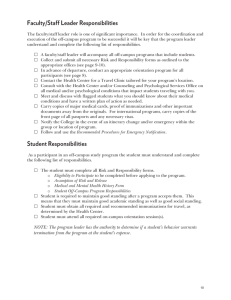
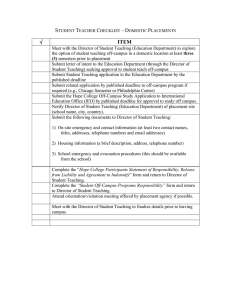
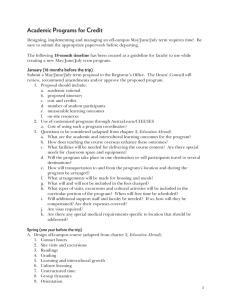
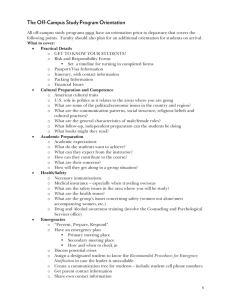
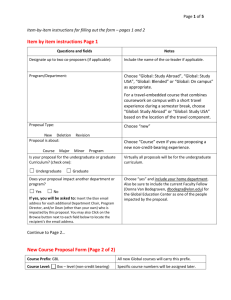
![WHEREAS, [school] has a policy that allows university](http://s3.studylib.net/store/data/008503324_1-7de4f59666f764aad2ad9a6afc4eefde-300x300.png)